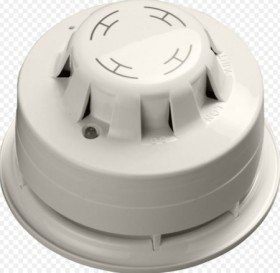With the wide choice available, selecting the correct detector or combination of detectors is of paramount importance to ensure that fire is detected at the earliest possible point.
However, this also needs to be balanced with other factors such as minimising the risk of false alarms.
Fire detectors are designed to detect one or more of the four characteristics of fire: heat, smoke, combustion gas or infrared or ultraviolet radiation. Detectors will trigger an alarm system once one of these characteristics is identified.
There are several different types of detector available, designed to trigger a fire alarm system. Smoke detectors are probably the most common, along with heat detectors, beam detectors, CO detectors, air aspiration, flame detectors and more.

Apollo AlarmSense Combined Optical Smoke Detector
The choice of detector depends wholly on the environment it’s to be used in, combined with consideration of the type of fire it will be detecting. For example, a commercial kitchen would be suited more to a fixed temperature heat detector rather than a smoke detector where smoke from food preparation is commonplace.
Carbon monoxide detection would be appropriate for use in a sawmill where early detection of a smouldering fire is necessary to help prevent a potentially major fire taking hold. In this environment smoke or heat detection would only trigger once the fire has grown significantly enough to produce flames and smoke and so creating a potentially life-threatening situation.
Consideration also needs to be given to the reason for the protection. For example, if the susceptibility of areas surrounding a large piece of machinery to fire was the main concern then heat detection may be appropriate.
However, if the concern was to protect the machinery from an electrical cable fire (because the machinery was integral to a revenue stream for the business), then protecting the cabling area with smoke detection would be the suitable option.
The main point in question is that clearly one type of fire detector isn’t suitable for all applications, and the final choice will depend on several factors:
- The speed of fire detection required, based on an assessment of the fire risk
- Minimising false alarms, which can be caused by incorrect detection devices
- The nature of the fire hazard to be protected
- The probable growth and spread of a fire
- Environmental factors present – for example dust, humidity, temperature and smoke from other sources
- The size and expanse of the area to be protected
In conclusion, only a full fire-risk assessment will determine the fire risks to a site and the most suitable category of fire alarm to be fitted. It is then the responsibility of the fire-alarm designer and installer to determine the most suitable type of detection for a site.
The importance in getting this correct in relation to fire risk type and environmental factors is paramount.
2023 Fire Safety eBook – Grab your free copy!
Download the Fire Safety in 2023 eBook, keeping you up to date with the biggest news and prosecution stories from around the industry. Chapters include important updates such as the Fire Safety (England) Regulations 2022 and an overview of the new British Standard for the digital management of fire safety information.
Plus, we explore the growing risks of lithium-ion battery fires and hear from experts in disability evacuation and social housing.